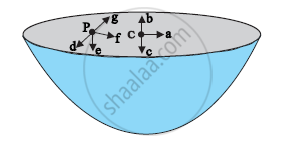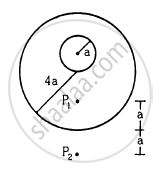Advertisements
Advertisements
Question
Particles of masses 2M, m and M are respectively at points A, B and C with AB = ½ (BC). m is much-much smaller than M and at time t = 0, they are all at rest (Figure). At subsequent times before any collision takes place ______.

Options
m will remain at rest.
m will move towards M.
m will move towards 2M.
m will have oscillatory motion.
Solution
Particles of masses 2M, m and M are respectively at points A, B and C with AB = ½ (BC). m is much-much smaller than M and at time t = 0, they are all at rest (Figure). At subsequent times before any collision takes place m will move towards 2M..
Explanation:
The particle m at B will move towards A with the greater force, due to particle 2M at A.
Force on m at B due to 2M at A is
`F_(BA) = (G(m xx 2M))/(AB)^2` towards `BA`
Force on mass m at B due to mass M at C is
`F_(BC) = (G(M xx M))/(BC)^2` towards `BC`
Therefore, the resultant force on mass m at B due to masses M and 2M is
`F_"net" = F_(BA) - F_(BC)` .....(Because FBA and FBC are acting in opposite directions)
`F_"net" = (2GMm)/(AB)^2 - (GMm)/(BC)^2`
As `(BC) = 2AB`
⇒ `F_"net" = (2GMm)/(AB)^2 - (GMm)/(2AB)^2`
= `(2GMm)/(AB)^2 - (GMm)/(4(AB)^2`
= `(7GMm)/(4(AB)^2` (along BA)
Hence, m will move towards BA (i.e., 2M).
APPEARS IN
RELATED QUESTIONS
What happens to the force between two objects, if the distance between the objects is doubled and tripled?
The gravitational intensity at the centre of a hemispherical shell of uniform mass density has the direction indicated by the arrow (see Fig 8.12) (i) a, (ii) b, (iii) c, (iv) 0.

A uniform metal sphere of radius a and mass M is surrounded by a thin uniform spherical shell of equal mass and radius 4a (In the following figure). The centre of the shell falls on the surface of the inner sphere. Find the gravitational field at the points P1 and P2 shown in the figure.

A particle of mass 100 g is kept on the surface of a uniform sphere of mass 10 kg and radius 10 cm. Find the work to be done against the gravitational force between them to take the particle away from the sphere.
Explain the following:
People often shake the branches of a tree for getting down its fruits.
What is meant by the equation :
`g= Gxxm/r^2`
where the symbols have their usual meanings.
The distance-time values for an object moving along straight line are given below:
| Time (s) | Distance (m) |
| 0 | 0 |
| 1 | 1 |
| 2 | 8 |
| 3 | 27 |
Mahendra and Virat are sitting at a distance of 1 m from each other.Their masses are 75 kg and 80 kg respectively. What is the gravitational force between them? (G = 6.67 × 10-11 Nm2/kg2)
The gravitational force between a hollow spherical shell (of radius R and uniform density) and a point mass is F. Show the nature of F vs r graph where r is the distance of the point from the centre of the hollow spherical shell of uniform density.
Four identical particles of equal masses 1 kg made to move along the circumference of a circle of radius 1 m under the action of their own mutual gravitational attraction. The speed of each particle will be ______.
